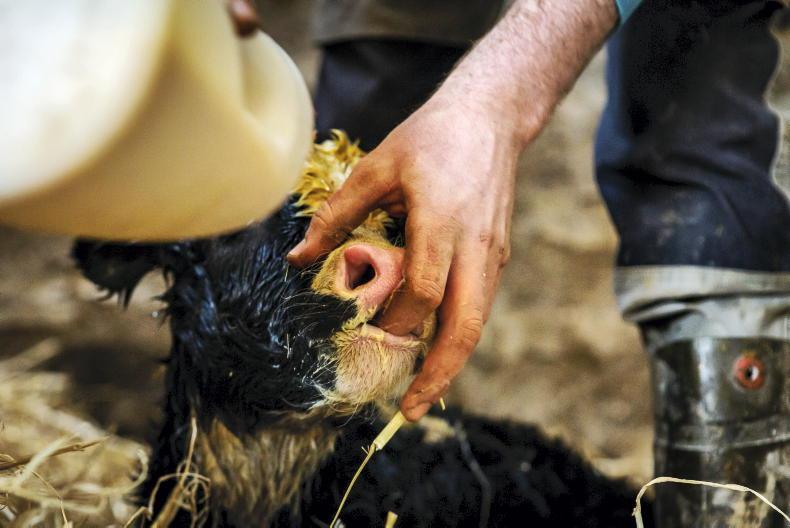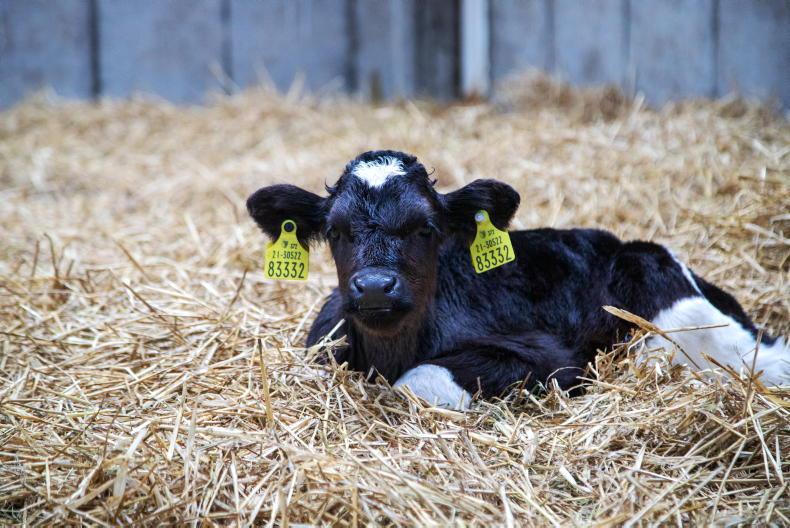Dairylink Ireland participants reviewed the performance of heifer calves on their farms during an online meeting last week.
Action points to improve growth rates were identified and will be implemented during the next calving season.
Calf rearing strategies have assumed increasing importance in the dairy industry with research showing that heifer calves which achieve a pre-weaning liveweight gain (LWG) greater than 0.8kg/calf/day produce more milk during their first lactation and have longer lifespans.
Phase two Dairylink farmers have been monitoring LWG among their calves this season and discussed their findings with Sarah Campbell from MSD Animal Health and Dr Alastair Boyle from CAFRE.
The main point was that average pre-weaning LWG across the project farms varied from 0.53 – 0.83kg/calf/day.
Feeding programmes on the farms varied, from feeding up to 8l pasteurised milk/ calf daily on Stephen and Hazel Wallace’s farm, to feeding 1.1kg milk replacer/ calf daily on Richard Marshall’s farm.
All calves appeared to be weaned at around eight to 10 weeks old. The group concluded that several practices were responsible for the differences in performance.
Feeding colostrum
Feeding an adequate amount of colostrum (4l) shortly after birth is critical to enhancing a calf’s immunological status.
However, CAFRE’s Alastair Boyle added that offering an additional feed of colostrum/transition milk as a second/third feed will also enhance performance.

Calves should get at least four litres of colostrum shortly after birth. \ Philip Doyle
Project farmers were also encouraged to monitor colostrum quality using a refractometer and blood ZST levels among calves, to ensure satisfactory uptake by the calves.
Some of the farmers reported that monitoring colostrum quality had helped ensure that newborn calves received good-quality colostrum.

A BRIX refractometer can be used to measure the quality of colostrum.
For example, Frank Goodman reported that he had recently tested colostrum from a freshly-calved heifer and found that it had a BRIX score less than 20.
As a result, he used some frozen colostrum to feed the newborn calf instead. All colostrum samples tested since then were found to be satisfactory, with a BRIX score greater than 22.
Weighing calves
Weighing animals should be an essential practice on every heifer-rearing enterprise. Carrying out this exercise will allow you to determine if targets are being reached and whether any changes need to be made.
For example, when John Oliver weighed his calves recently, it confirmed his suspicions that calves were not meeting weight targets.
This in turn caused him to review his feeding programme, where he found that calves were receiving 750g milk replacer/calf/day instead of the planned amount (850g/calf/day).
John has since corrected the feeding levels and is satisfied with progress following the changes.
Phase two Dairylink farmers have access to a weighbridge, which they can use to monitor calves.
However, using a weigh band in the appropriate manner will also allow you to assess calf weights in the absence of a weighbridge. Therefore, not having a weighbridge should not be seen as an obstacle to monitoring LWG of calves.
Milk replacer
Dairylink farmers feeding increased rates of milk replacer (over 850g/calf/ day) were encouraged to use a product that limited lactose intake to less than 400g/calf/day, which would reduce the risk of nutritional scours.
James Martin reported that he had recently changed his milk replacer to reflect this point and that he had noticed fewer incidences of scour as a result.
Health status
Sarah Campbell from MSD Animal Health commented that any health disorder that a calf endures will negatively impact LWG.
It is therefore important to record all incidences of health disorders among calves to identify any underlying problems and incorporate this into the action points within an animal health plan.
Environment
Ensure that the calf is reared in a clean, dry, draught-free environment. Dairylink farmers gave some thought as to how this could be enhanced within their own farms. Various options were discussed, from using calf jackets to building new facilities.
Action points for next year
The group arrived at the following action points to be implemented at the next calving season:
Record birth weights and weaning weights of calves.Monitor colostrum quality and take blood samples from a number of calves to assess ZST levels.Record all incidences of calf health disorders on the farm.Liveweight gains in heifer calves varies across Dairylink Ireland farms.All programme farmers plan to monitor colostrum quality, blood ZST levels and incidences of health problems next season.Dairylink participants will also weigh calves regularly and monitor weight gains.
Dairylink Ireland participants reviewed the performance of heifer calves on their farms during an online meeting last week.
Action points to improve growth rates were identified and will be implemented during the next calving season.
Calf rearing strategies have assumed increasing importance in the dairy industry with research showing that heifer calves which achieve a pre-weaning liveweight gain (LWG) greater than 0.8kg/calf/day produce more milk during their first lactation and have longer lifespans.
Phase two Dairylink farmers have been monitoring LWG among their calves this season and discussed their findings with Sarah Campbell from MSD Animal Health and Dr Alastair Boyle from CAFRE.
The main point was that average pre-weaning LWG across the project farms varied from 0.53 – 0.83kg/calf/day.
Feeding programmes on the farms varied, from feeding up to 8l pasteurised milk/ calf daily on Stephen and Hazel Wallace’s farm, to feeding 1.1kg milk replacer/ calf daily on Richard Marshall’s farm.
All calves appeared to be weaned at around eight to 10 weeks old. The group concluded that several practices were responsible for the differences in performance.
Feeding colostrum
Feeding an adequate amount of colostrum (4l) shortly after birth is critical to enhancing a calf’s immunological status.
However, CAFRE’s Alastair Boyle added that offering an additional feed of colostrum/transition milk as a second/third feed will also enhance performance.

Calves should get at least four litres of colostrum shortly after birth. \ Philip Doyle
Project farmers were also encouraged to monitor colostrum quality using a refractometer and blood ZST levels among calves, to ensure satisfactory uptake by the calves.
Some of the farmers reported that monitoring colostrum quality had helped ensure that newborn calves received good-quality colostrum.

A BRIX refractometer can be used to measure the quality of colostrum.
For example, Frank Goodman reported that he had recently tested colostrum from a freshly-calved heifer and found that it had a BRIX score less than 20.
As a result, he used some frozen colostrum to feed the newborn calf instead. All colostrum samples tested since then were found to be satisfactory, with a BRIX score greater than 22.
Weighing calves
Weighing animals should be an essential practice on every heifer-rearing enterprise. Carrying out this exercise will allow you to determine if targets are being reached and whether any changes need to be made.
For example, when John Oliver weighed his calves recently, it confirmed his suspicions that calves were not meeting weight targets.
This in turn caused him to review his feeding programme, where he found that calves were receiving 750g milk replacer/calf/day instead of the planned amount (850g/calf/day).
John has since corrected the feeding levels and is satisfied with progress following the changes.
Phase two Dairylink farmers have access to a weighbridge, which they can use to monitor calves.
However, using a weigh band in the appropriate manner will also allow you to assess calf weights in the absence of a weighbridge. Therefore, not having a weighbridge should not be seen as an obstacle to monitoring LWG of calves.
Milk replacer
Dairylink farmers feeding increased rates of milk replacer (over 850g/calf/ day) were encouraged to use a product that limited lactose intake to less than 400g/calf/day, which would reduce the risk of nutritional scours.
James Martin reported that he had recently changed his milk replacer to reflect this point and that he had noticed fewer incidences of scour as a result.
Health status
Sarah Campbell from MSD Animal Health commented that any health disorder that a calf endures will negatively impact LWG.
It is therefore important to record all incidences of health disorders among calves to identify any underlying problems and incorporate this into the action points within an animal health plan.
Environment
Ensure that the calf is reared in a clean, dry, draught-free environment. Dairylink farmers gave some thought as to how this could be enhanced within their own farms. Various options were discussed, from using calf jackets to building new facilities.
Action points for next year
The group arrived at the following action points to be implemented at the next calving season:
Record birth weights and weaning weights of calves.Monitor colostrum quality and take blood samples from a number of calves to assess ZST levels.Record all incidences of calf health disorders on the farm.Liveweight gains in heifer calves varies across Dairylink Ireland farms.All programme farmers plan to monitor colostrum quality, blood ZST levels and incidences of health problems next season.Dairylink participants will also weigh calves regularly and monitor weight gains. 







 This is a subscriber-only article
This is a subscriber-only article










SHARING OPTIONS: